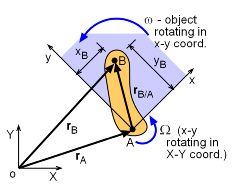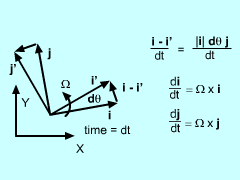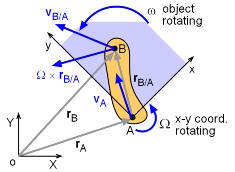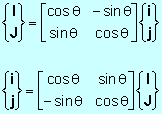| Ch 5. Rigid Body General Motion | Multimedia Engineering Dynamics | ||||||
| Fixed Axis Rotation | Plane Motion Velocities | Zero Velocity Point | Plane Motion Accelerations |
Multiple Gears |
Rot. Coord. Velocities | Rot. Coord. Acceleration | |
| Rotating Coordinates: Velocities | Case Intro | Theory | Case Solution | Example |
| Chapter |
| - Particle - |
| 1. General Motion |
| 2. Force & Accel. |
| 3. Energy |
| 4. Momentum |
| - Rigid Body - |
| 5. General Motion |
| 6. Force & Accel. |
| 7. Energy |
| 8. Momentum |
| 9. 3-D Motion |
| 10. Vibrations |
| Appendix |
| Basic Math |
| Units |
| Basic Dynamics Eqs |
| Sections |
| eBooks |
| Dynamics |
| Fluids |
| Math |
| Mechanics |
| Statics |
| Thermodynamics |
| ©Kurt Gramoll |
|
|
|||||
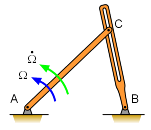 Example of rotating rigid bodies with moving point on one body |
Previously, multiple rigid bodies that were connected with pin joints were analyzed. This section considers the same rigid body motion, but now a point on one of the rigid bodies is allowed to moved and two coordinate systems are used to model the motion. A good example of this type of motion would be two links connected with a sliding connection, as shown in the diagram. To analyze a rotating rigid body with a moving point we need to start with the basic relative position vector equation and take a time derivative. To help with modeling complex systems, two coordinate systems are used: X-Y is fixed and x-y rotates in the X-Y system. Note, x-y system is not fixed to the body. |
||||
|
|
Start with the basic position vector, rB = rA + rB/A The first time derivative gives, d(rB)/dt = d(rA + rB/A)/dt A simple derivative for rB/A is not correct since the coordinate system, x-y, also is changing which must be accounted for when taking a derivative. |
||||
|
Using xB and yB as the scalar components of rB/A gives, vB = vA + d(xAi + yBj)/dt It is important to note that di/dt ≠ 0 and dj/dt ≠ 0 since i and j can rotate. Using the chain rule, this can be expanded as The unit vectors, i and j, can rotate so their time derivatives are di/dt = Ω × i and dj/dt = Ω × j. Also, note that dxB/dt i and dyB/dt j is simply the relative velocity of B with respect to A. This gives vB = vA + (vB/A)rel + xBΩj + yBΩi The last two terms can be converted to a cross product to give This is the classic form of the relative motion equation using rotating axes. The key term is Ω × rB/A which relates the x-y coordinate system with the X-Y coordinate system. |
||||
| Coordinate Transformation |
|||||
Since two coordinates are involved with most rotating coordinate system problems, they need to be related. In other words, one coordinate system needs to be mapped into the other, and vce versa. Relating two coordinate system is a common task in most all engineering fields, not just dynamics. |
|||||
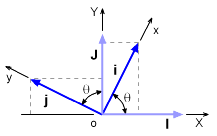 Velocity vectors |
The easiest way to relate coordinate systems is to descripbe one system in the other, just like is done for a point or vector. For example, the i unit-vector i can be described in the coordinate system XY as i = cosθ I + sinθ J likewise, the j unit-vector is j = -sinθ I + cosθ |
||||
These relationships can be inverted to describe I and J using i and j unit-vectors I = cosθ I - sinθ J |
|||||
These transformation equations are commonly written in matrix form, and called the 2D coordinate transformation matrix
They can be used for any two coordinate systems where the xy-system is rotated an angle θ relative to the XY-system. |
|||||
